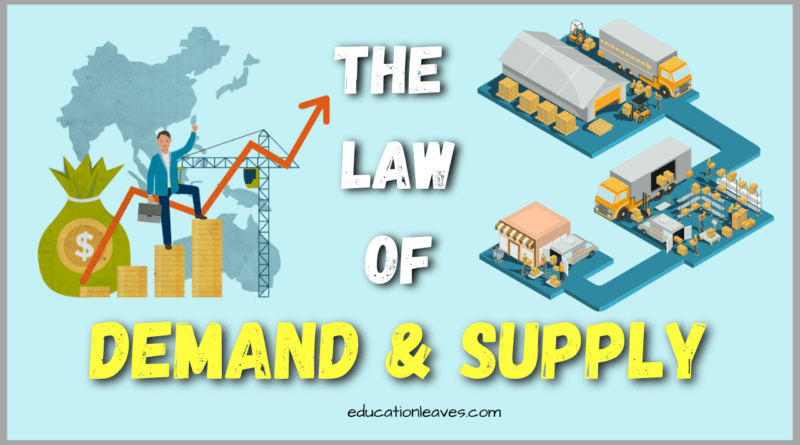Law of Demand and Supply: [PDF Included] Curves, Importance, Conditions, & Factors Affecting Demand and supply
The Law of demand and supply is a concept in economics that explains the relationships between demand, supply, and price of products and services. This concept is the combination of the law of demand and the law of supply.
The law of supply and demand is possibly one of the most essential concepts and it is the backbone of an economy. According to the law of demand and supply, when there is a higher demand for a product or service, there is a rise in the supply of such product or service and vice versa. The law of demand and supply describes the interaction between the desire for a product and the supply of that product. For example, if the supply of a product is low and the demand is high, it signifies such product is lacking for the number of people that desires it, therefore, it will lead to an increase in the price of the product.
What you are going to learn?
Law of Demand

Before heading into the law of demand and supply, first, we should know the Law of Demand. The Law of demand demonstrates that, if the other economic factors remain unchanged, then the higher the price of a product, the fewer people will urge that product. In simple words, if the price is increased then the demand will be decreased.
When everything is constant but demand is high, then the price of the product goes up. As a result, people will avoid buying those products and consider other products. This is because when the price increases, the opportunity cost of purchasing the good also increases.
Factors that Affecting Demand
Here are five major factors that affect the demand for a specific product;
1. Own Price:
This is the most determinant factor of demand. When the own price of a product falls demand increases and when the own price increases, demand falls. So, we can see there is an indirect relationship between own price and demand.
2. Price of related products:
There are two types of related products:
- Substitute Products: When the price of the substitute products’ falls the demand for the specific product falls, and when the price of the substitute product rise, the demand for the specific products increases. So there is a direct relation between the price of the substitute products and the demand for the specific product.
- Complementary good: When the prices of complementary goods increase, the demand for the given item drops. And when the price of complementary goods drops, the demand for the given item increases. For instance, when the price of diesel or petrol rises, automatically the demand for cars falls.
3. Income of the Consumer:
There are three types of products:
- Normal products: The demand for normal products like household commodities, and foods rises with the rise in income and falls when income decreases. So there is a direct relationship between the demand for normal products and the income.
- Inferior Products: The demand for inferior products rises with the fall of income and falls when income increases. So there is a negative relationship between the demand for normal products and the income.
- Necessities: The demand for necessities doesn’t change with income. Example: Drugs.
4. Preferences:
The demand for a product is also influenced by tastes and preferences.
It increases if there is a promising change in the tastes and preferences of the consumer.
5. Forecast:
Future anticipations about price and income also influence the demand for a product in the present. Assume, that if we predict an increase in price in the near future, then we will rise in demand in the present even at the same price.
Law of Supply
![Law of Demand and Supply: [PDF Included] Curves, Importance, Conditions, & Factors Affecting Demand and supply](https://educationleaves.com/wp-content/uploads/2022/08/pngegg-1.png)
The law of supply demonstrates that when all other economic factors remain constant, the price and quantity of supply of product have a direct relationship. It means, that as the price of a product increases, the quantity that suppliers are willing to provide increases because, with every extra unit that the seller delivers, the opportunity cost will naturally grow.
However, as the price that people are comfortable paying for a product increases, the quantity that a supplier can justify providing increases.
Factors that Affecting Supply
There are several factors that affect supply;
1. Price of the Product:
The most important factor that affects supply directly is the price of that product. As the price rises, the quantity supplied of the product also increases and vice-versa. It occurs because, at higher prices, there are greater probabilities of making a profit. It causes the company to deliver more for sale in the market.
2. Prices of Other Products:
The amount supplied of a product relies not only on its price but also on the prices of other products. A rise in the prices of other products makes them more profitable in comparison to the given product. As a result, the company shifts its defined resources from the production of the given product to the production of other commodities.
3. Technology:
Sometimes, technological Changes influence the supply of a product. Improved technology reduces the cost of production which increases the profit margin for a company. It causes the seller to boost the supply.
4. Taxation Policy:
Increasing taxes force the manufacturer to lower production due to low-profit margin, therefore, the supply of a product is also reduced. On the other hand, subsidies and tax concessions increase the supply because of the high-profit margin.
5. Market trend:
Market trends directly affect supply. When a new trend arrives, the company has to manufacture that product in huge quantities with a low-profit margin. The main purpose of such activity is to grab extensive markets and enhance their status.
Demand and Supply Curves
Demand and supply curves are a method to represent the number of products demanded and supplied on a graph for a given interval of time.
At any point of time, the demand curve is always downward sloping due to the law of decreasing marginal utility, while the supply curve is a vertical line as the supply of a product bought to market is fixed at a given point of time.
In simple words, the direct relationship between the price and supply makes an upward-sloping supply curve. On the other hand, the inverse relationship between price and demand makes a downward sloping demand curve.

Equilibrium Price
When the quantity of supply of products reaches the demand for products, it is called the equilibrium price or the market clearing price. In simple words, the equilibrium price is a neutral point of price where both sellers and buyers are satisfied.
On the Demand and supply curves, where the demand line touches the supply line, that price point is called the equilibrium price.
Shifts
The shift in a demand and supply curve happens when a huge quantity of a product is demanded or supplied but the price is constant. Shifts in demand or supply curve imply that the original demand and supply relationship has changed. Shifts happen due to some factors. For example, the price for a bottle of Redbull energy drink is 2$. Suddenly the government bans all energy drinks except Redbull. In this condition, the demand for Redbull will increase.
In this case, the demand increased and the supply decreased. So there would be a shift in the supply of Redbull.
In the same way, a shift in the supply curve happens if, for example, a mass shortage of raw materials will force the manufacturer to manufacture less and supply less Redbull for the same price point of 2$.
Basic Conditions of Demand & Supply
- Demand Increases but supply remains unchanged: This condition will lead to a price hike. Basically, the shortage of products rise the value of the products.
- Demand Increases but supply remains unchanged: At this condition, the price of a product decreases. When the demand continues to drop, there will be a surplus of the product in the market, thereafter, draining the product’s value.
- Supply increases but demand remains unchanged: When demand is the same but supply increases, it will lead to a decrease in price due to easy availability.
- Supply decreases but demand remains unchanged: When demand is constant for a specific product but the supply decreases, this situation leads to a price hike for that specific product.
| Demand | Supply | Price | Scenario |
| Increases | Constant | Hikes | Deficiency |
| Decreases | Constant | Drops | Surplus |
| Constant | Increases | Drops | Surplus |
| Constant | Decreases | Hikes | Deficiency |
Benefits of Demand and Supply
There are several benefits of demand and supply;
1. Creation of Value:
The cross-functional system that facilitates combined demand and supply planning also helps businesses to focus on customer-centric metrics that make higher value for both businesses and consumers.
2. Better Internal and External Collaboration:
Supply and demand planning means managers have to collaborate more closely with both internal departments and external partners. Relationships with supply chain associates are promoted beyond buy-sell transactions to include collective coordination and planning, as well as a willingness to share both knowledge and risk. It improves the operational efficiency of the entire organization.
3. More Strategic Resource Allocation:
If you consider both the supply and demand side, you can understand the big picture and can able to make better decisions on resource allocation to create the most value for consumers, satisfy consumer demands, and generate more sales.
4. Focus On Profitability:
The main objective of the law of demand and supply is to fulfill consumers’ needs while maintaining profit margins. The focus on profitability leads businesses to simplify their processes and create flexibility and fluid scheduling to react to market changes.
Law of Demand and Supply PDF
Related Articles:
Supply Chain Management:
A supply chain is an integrated network of individuals, associations, resources, activities, and technologies applied in the manufacture and sale of a product or service. A supply chain begins with the delivery of raw materials from a supplier to a factory and ends with the delivery of the finished products or services to the end consumer. Read more>>>
Demand Forecasting:
Demand forecasting is the organized process to assess future demand for a specific good. Simply put, it lets you assess the sales scientifically over upcoming weeks, months and years, so that you know exactly how much inventory to order and maintain at any given time period. Read more>>>
https://pluginstorrents.com/ https://whitecrack.com/ https://hdlicensed.com/ https://plug-torrents.com/ https://cracks4soft.com/




Pingback: What is Capitalism? Definition, Characteristics, Benefits, Negatives, Relationship with Socialism & Democracy, Demand and supply - EDUCATIONLEAVES
Pingback: What is Work-Life Balance & How Does it Benefit your life? - EDUCATIONLEAVES